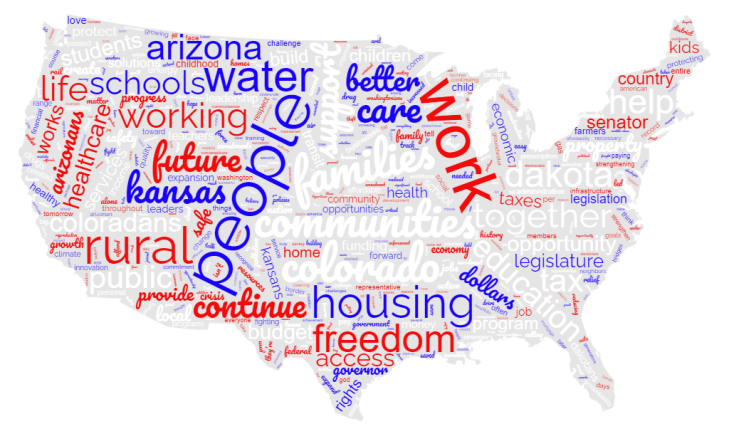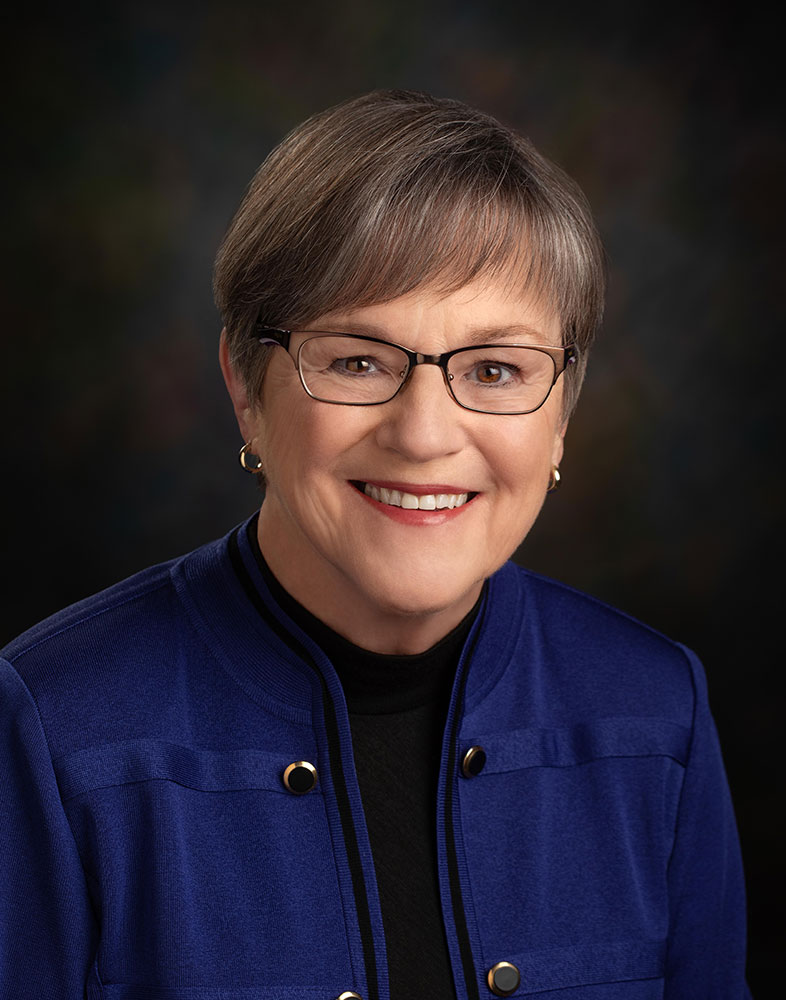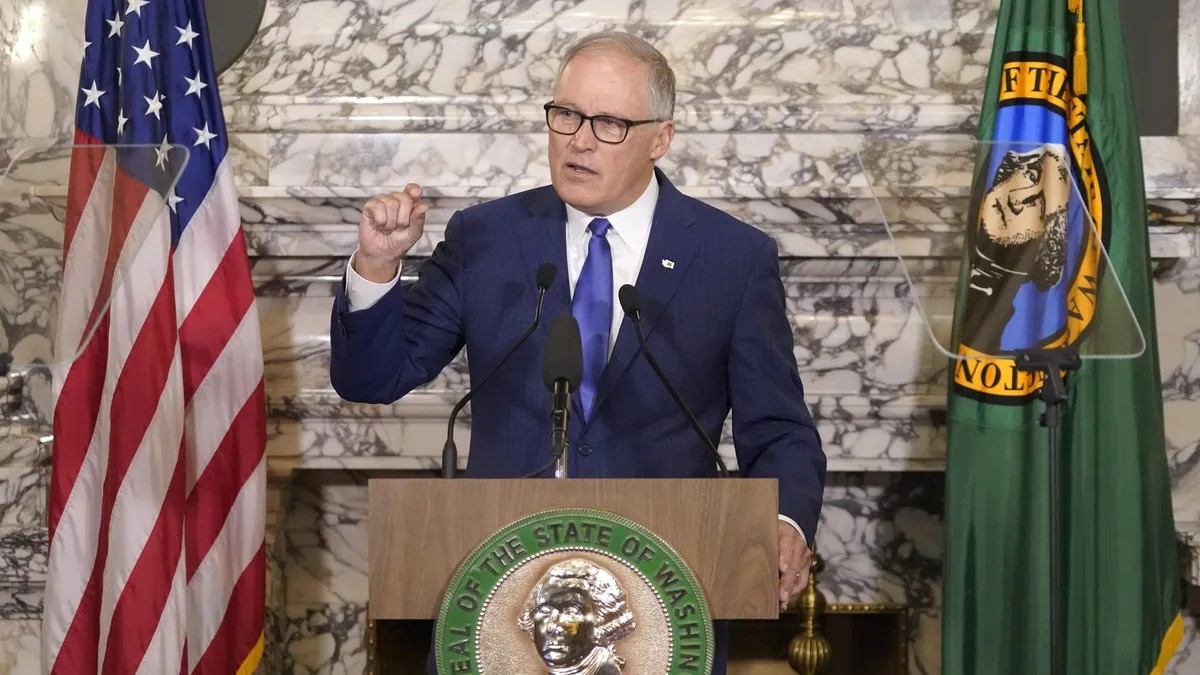01/11/24
Best of the West: Governors outline legislative priorities in State of the State addresses; Regional income growth; A voluntary carbon market for tourism; Continuous methane monitoring; and more

The Western Governors' Association keeps you updated on the latest news in the West. Here are the top stories for the week starting January, 8, 2024. (Photos courtesy of Colorado Public Radio, Doug Lock-Smith, Adam Thury / Mitchell Republic, and BNN Breaking News).
The "word cloud" above was created using the topics most often mentioned by the Governors in their addresses.
Several Western Governors kicked-off the 2024 legislative sessions this week by outlining their policy priorities in the 2024 State of the State addresses.
.jpg) In her second State of the State address, Arizona Governor Katie Hobbs emphasized the importance of bipartisan cooperation during this year’s session as the legislature looks to tackle complicated issues related to housing affordability, water resources, and education.
In her second State of the State address, Arizona Governor Katie Hobbs emphasized the importance of bipartisan cooperation during this year’s session as the legislature looks to tackle complicated issues related to housing affordability, water resources, and education.
She proposed the creation of the Arizona Is Home Mortgage Assistance Program, which will help working-class families throughout the state with down payment assistance, mortgage interest rate relief, and by providing access to less costly home loans for working-class households in rural areas.
She also spoke about the need to protect the state’s water resources by closing the loopholes that allow build-to-rent and wildcat developments and updating the state’s groundwater management laws. To this end she proposed the Alternative Designation of Water Resources program, which would provide an opportunity for groundwater users to achieve a one-hundred-year assured water supply by contributing new water sources and reducing groundwater pumping.
Building upon the AZ Healthy Tomorrow program, which Governor Hobbs helped launch in 2023, she also called on this year’s legislature to support a new engineering-focused medical school at Arizona State University; to double the size of University of Arizona medical schools; and to start a new medical school focused on serving rural and tribal communities at Northern Arizona University.
As the state’s budget outlook improves due to a nation-leading $32 billion in foreign investment in 2023, Governor Hobbs said the state should also fund additional scholarship programs for students from low-income households and provide students the opportunity to earn college credits while still in high school.
Read the full transcript of Governor Hobss’ State of the State address here.
 Colorado Governor Jared Polis spent roughly a third of his State of the State Address speaking about housing and transportation.
Colorado Governor Jared Polis spent roughly a third of his State of the State Address speaking about housing and transportation.
As for housing, Governor Polis unveiled a second attempt at land-use reforms, and incentives to develop transit oriented and connected communities.
Of course, in order to develop these transit-oriented neighborhoods, he said the state must improve its transit system, and especially the state’s commercial rail service.
To do so, he said the state should leverage the $6 billion dollars the federal government has approved to improve rail lines throughout the country to fund the Front Range Passenger Rail plan and deliver on the FASTtracks promise. These efforts, he said, must also be combined with a more expensive, statewide bus system.
Aside from housing and transportation, he also spoke about the need to increase investments and build upon the success of programs that the legislature created in recent years, including the state’s Agricultural Workforce Development Program, Opportunity Now, I Matter, and the Colorado Water Plan, just to name a few.
Read the full transcript of Governor Polis’ 2024 State of the State Adress here.
 Idaho Governor Brad Little’s 2024 State of the State address focused on his IDAHO WORKS plan, which seeks to continue to build upon the economic success of the state in recent years by investing in the state’s critical infrastructure.
Idaho Governor Brad Little’s 2024 State of the State address focused on his IDAHO WORKS plan, which seeks to continue to build upon the economic success of the state in recent years by investing in the state’s critical infrastructure.
The big-ticket items are a $2 billion investment in school facilities over the next 10 years and $75 million to fund the Idaho LAUNCH program to strengthen the state’s pipeline of skilled workers.
An additional $200 million was proposed for the improvement of dilapidated bridges throughout the state and $50 million to bond for an additional $800 million for other badly needed transportation projects.
Another $30 million was recommended to ensure the state’s water supply and $6.5 million to continue the state’s response to invasive quagga mussels.
Read the full transcript of Governor Little’s 2024 State of the State address here.
 Kansas Governor Laura Kelly focused her state of the state address on how the state can support its rural communities. To do so, she outlined several priorities.
Kansas Governor Laura Kelly focused her state of the state address on how the state can support its rural communities. To do so, she outlined several priorities.
In terms of education, the second-term Governor proposed the largest single-year investment ever made in our state’s early childhood system, a large part of which will go toward addressing the state’s childcare shortage. To further streamline early childhood services, she proposed the development of an “Office of Early Childhood” - creating a one-stop-shop for young families, childcare providers, and businesses.
To address the growing cost of living, she proposed completely eliminating state taxes on Social Security increasing the standard deduction and raising the residential statewide property tax exemption from $42,000 to $100,000, which would expand the tax cut to 370,000 Kansas in the Sunflower state.
To end the states “existential” water crisis, Governor Kelly promised to fully fund the State Water Plan for the third year in a row, providing additional funding for rural towns to update their water systems, as well as to help farmers and ranchers implement water-saving practices. The funding will also provide resources for the new Kansas Water Institute at K-State.
Read the full transcript of Governor Kelly’s 2024 State of the State Adress here.
.jpeg) South Dakota Governor Kristi Noem's 2024 State of the State address focused on the state’s efforts “to ensure that Freedom Works Here.”
South Dakota Governor Kristi Noem's 2024 State of the State address focused on the state’s efforts “to ensure that Freedom Works Here.”
Along with work to enhance outdoor opportunities and protect the state’s agricultural heritage by restrict foreign adversaries from purchasing ag land in South Dakota, and expanding rehabilitation programs, much of her address focused on workforce development and education.
She encouraged the legislature to increase teacher pay, to provide additional support for the Jobs for America’s Graduates program and to extend tuition for South Dakota National Guardsmen and women to 100% of private colleges in the Mount Rushmore State.
She also detailed a South Dakota Department of Health program that will roll out a $7.5 million grant program to ambulance services and support the implementation of regional hubs and touted the work of the state’s Telemedicine in Motion program to expand telemedicine programs throughout the state.
Read the full transcript of Governor Noem’s 2024 State of the State address here.
 Washington Governor Jay Inslee delivered his 11th State of the State address on January 8 at the state Capitol building in Olympia.
Washington Governor Jay Inslee delivered his 11th State of the State address on January 8 at the state Capitol building in Olympia.
Having proposed a $70.9 billion supplemental budget for 2024, Governor Inslee said the state is primed to invest in big-ticket items such as expanding behavioral health resources, reducing greenhouse gases and supporting clean energy jobs, combating the opioid and fentanyl crisis, investing in housing and homelessness solutions, and supporting school workers.
The Governor proposed increasing the pay for 32,000 paraeducators in the state by $3 per hour, raising the cap on special education funding, and creating incentives for more teachers to serve special needs students.
He also proposed $64 million in new funding to fight against opioids and fentanyl, including investments in education, community health hubs, overdose prevention, treatment access, and recovery supports.
Of course, Governor Inslee also spoke about the state’s efforts to reduce greenhouse gas emissions. Building upon the Climate Commitment Act, which was approved by the legislature in 2023, he proposed a $200 utility bill credit for nearly 2 million low- and moderate-income Washingtonians, as well as an initiative to help thousands more families install energy-efficient heat pumps. In that same vein, he said the state “must do everything possible” to expedite the construction of cleaner, more efficient ferries.
Read the full transcript of Governor Inslee’s 2024 State of the State address here.
Income Growth: The U.S. Census Bureau recently released the 2018-2022 American Community Survey. It reported that the top five states for median household income growth, compared to the previous American Community Survey from 2013-2017, are all located in the West. Idaho’s median household income increased by 15%, California’s grew by 14.3%, Oregon’s increased 14%, Washington’s increased 14%, and Arizona grew by 13.3%.
Voluntary Carbon Markets for Tourism: In an effort to mitigate a portion of the CO2 emitted by the tourism industry in Juneau, Alaska, those going whale watching or visiting the Mendenhall Glacier are asked to pay a few dollars to counter their emissions. The money goes to the Alaska Carbon Reduction Fund, but instead of buying credits from a carbon offset project, the nonprofit spends that cash installing heat pumps.
Methane Monitoring: The Department of Energy's loan office conditionally approved a $189 million loan to support the build-out of a methane monitoring network in key oil-producing basins that would provide real-time data for tens of thousands of oil and gas sites, which it estimates could prevent the equivalent of at least 6 million tons of carbon dioxide per year. Houston-based Long Path Technologies will use the loan to deploy its Emissions Overwatch System across 24,000 square miles in several states. Unlike optical gas imaging, the Long Path system can continuously monitor 8-square mile (21-square km) areas, which could provide updates every two hours and notify operators in the event of a leak.
Transforming Grain Farming: A 48-year-old New York billionaire named Stephan Soloviev has been buying land in Colorado, Kansas, and New Mexico since he was in his 20s and is working to transform the world of grain farming. Soloviev says if all goes as planned, he'll stop farming on roughly 130,000 acres in eastern Colorado and western Kansas and rent the land to local farmers at market rates. The grain produced will be stored in his huge multi-million-dollar grain elevator at Sheridan Lake near the Colorado-Kansas border and loaded on trains using a private railroad he built that connect the grain elevator to the nationwide Union Pacific rail network. Soloviev told KUNC in an email the effort is focused on profitability, with an emphasis on profit for local ag producers.
A History Unlike Any Other: A team of researchers at the University of Oklahoma is exploring the Permian sediment of Oklahoma’s Anadarko Basin, which contains dust deposits from Earth’s deep-time past. The Anadarko Basin includes the most complete continental record of low-latitude Pangea, enabling researchers to better understand the collapse of one of Earth’s greatest glaciations, leading up to the largest extinction in Earth’s history. If successful in obtaining a complete sediment core, it will provide a record of Earth’s history unlike any other obtained thus far, allowing scientists to solve puzzles about Earth’s systems, including how tectonic and climatic shifts influence biological systems.